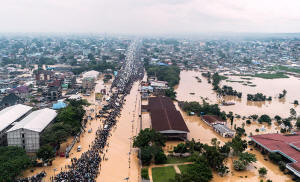|
Ten more people were confirmed dead as of Sunday evening, in
addition to the 23 people killed the day before, Congolese
Interior Minister Jacquemin Shabani said on state television
late Sunday.
Heavy rains began last week, causing the key Ndjili River to
overflow on Friday and submerge hundreds of buildings.
While the situation had improved by Monday morning, some access
roads remained blocked and vehicular traffic was limited.
Many residents blamed the government for not responding quickly
enough to the disaster.
“We lost everything and left everything behind,” said Marie
Nzola, one of those whose properties were destroyed. “The rain
caught us by surprise late at night.”
Officials said Sunday that most of the fatalities were caused by
walls that collapsed shortly after the deluge began.
The main road to the airport, which also links Kinshasa to the
rest of Congo, was damaged by the flooding but will be open to
all traffic within 72 hours, Kinshasa Gov. Daniel Bumba said
over the weekend.
The flooding has also hampered access to drinking water in at
least 16 communes after water facilities were affected, the
Congolese interior ministry said in a statement.
The government has set up at least four emergency shelters that
were catering to hundreds of displaced families across the city,
the ministry said.
Resident Clément Matwidi, one of those affected by the flooding,
expressed frustration and asked the government for more support.
“Everything is lost due to the floods (and) we are here waiting
for the government’s decision,” he said.
In 2022, at least 100 people were killed during similar flooding
in Kinshasa.
The disaster comes as the government is battling a humanitarian
disaster in the east of the country, more than 2,600 kilometers
(1,600 miles) from Kinshasa, where decades of fighting with
rebels escalated in February, worsening what is already one of
the world’s largest humanitarian crises.
All contents © copyright 2025 Associated Press. All rights
reserved |
|




